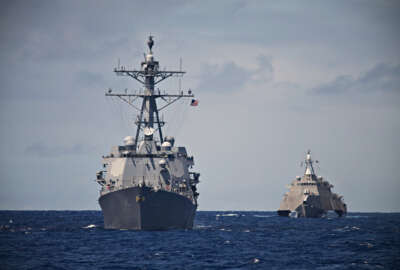Insight by Leidos
DoD Cloud Exchange 2023: Leidos’ Chad Buechel on consolidating 35 help desks, 30 networks and 2,500 data centers for DES
During Federal News Network’s DoD Cloud Exchange, Leidos’ Chad Buechel shares details on early progress developing a Defense Enclave Services transformation...
The Defense Enclave Services effort under the Fourth Estate Network Optimization initiatives aims to bring together thousands of users into a single service provider and create a common technology framework across 20 disparate organizations.
It’s one in a long list of major information technology modernization projects the Defense Department plans to complete over the next several years. But the one thing both DoD and its contractors know: Deploying at speed with innovation in a flexible approach will be the key to success.
By applying the lessons learned of past modernization projects, such as trying to create a one-size-fits-all approach, the Pentagon must put the needs of service members and civilians first and ensure consistent communications.
Chad Buechel, vice president and division manager for Defense Enclave Services at Leidos, said the goal is to understand and balance the unique needs of the end users while continuing to maintain services — and also develop a DES modernization roadmap.
To do that, Leidos has been working closely with the Defense Information Systems Agency on the roadmap. DoD awarded Leidos the $11.5 billion DES contract in March 2022 to consolidate and modernize 35 help desks, 30 networks and 2,500 data centers across 20 agencies.
“We’ve been performing work since July of last year, so we’ve had strong program performance thus far in terms of really getting in there, working with the customer, maintaining the operational environment and really starting to work with DISA to build that transformational roadmap and what that looks like moving forward,” Buechel said during Federal News Network’s DoD Cloud Exchange 2023. “We’re partnering very closely with DISA and really building out that journey. But the first six months really focused on operational performance, really getting to understand the baseline and then starting to drive some of those improvements.”
While the first nine months of DES has been doing what Buechel called “basic blocking and tackling,” the second year of the effort will bring in automation and innovation using the cloud to drive change.
“The team will identify what are those manual processes, what are the things we’re thinking about right now that are taking up time that we can do some scripting or some automating to relieve the manual processes,” he said. “Then we can start thinking about the bigger picture engineering efforts that we want to do to start accomplishing our overarching goals.”
Advanced cyber tools become more available
Those goals revolve around giving Fourth Estate agencies the ability to deploy modern technologies and innovate on their current and future capabilities at the speed of need.
Buechel said DES also must ensure warfighters have continuous support without any degradation of services.
“We are also trying to ensure that the user experience continues to be what it needs to be to support the end users,” he said.
But at the same time, DES will be migrating more services to the cloud. “We’re moving away from your traditional on-premise solutions, and we’re starting to do more and more in the cloud,” Buechel said. “What that offers us is the ability to rapidly deploy and innovate more of our cybersecurity tooling and the ability to do more analyzation and rapid data visualization of what’s going on — to manage and protect that data that we have up there.”
Leaning on software factories for innovation
At the same time, Buechel said the DES team must account for some inherent risks that come in using the cloud and lean on artificial intelligence and machine learning tools to protect data and networks.
The use of advanced data encryption, coupled with the resiliency of cloud services, will give DoD a powerful advantage to ensure warfighters are able to access data and tools when they need them, he said.
“We are continuing to drive innovation through a continuous process improvement effort. We know that what we did a year ago isn’t necessarily what we’re going to do now and how we’re going to move forward,” Buechel said. “DevSecOps is a great example for how we are going to work through an agile methodology.”
One major piece of the development, security and operations effort is the use of a software factory to help drive innovation.
Leidos has invested in creating these centers of excellence to support DES and other programs across DoD. The factories are especially important as the department moves toward a zero trust architecture, Buechel said.
“We are looking at how we can rapidly invest in those tools from a research and development standpoint to deploy and use those on our programs. How do we use some of that artificial intelligence and machine learning to automate many of the processes that we’re doing? So really looking at that,” he said. “Then with the cloud, how do we do that in a way that gets us rapidly migrating some of our on-premise programs into the cloud? And then being able to leverage that across the board to drive some of the initial enhancements and efficiencies we’re trying to achieve.”
To read or watch other sessions on demand, go to our 2023 DoD Cloud Exchange event page.
Copyright © 2024 Federal News Network. All rights reserved. This website is not intended for users located within the European Economic Area.
Related Stories
Featured speaker
-

Chad Buechel
Vice President and Division Manager, Defense Enclave Services, Leidos
-

Jason Miller
Executive Editor, Federal News Network
On DoD
Upcoming Events
Related Stories
Top Stories

Chad Buechel
Vice President and Division Manager, Defense Enclave Services, Leidos
Chad Buechel is the Vice President for Defense Enclave Services (DES) Business within Leidos’ Defense Group. In this role, he is responsible for developing strategic business priorities, leading growth campaigns, managing customer relationships, and delivering strong program performance for a multi-year contract with an estimated value of $11.5 billion. Through digital modernization and transformation, he leads a team charged with unifying the Fourth Estate DoD Agencies and Field Activities (DAFAs) on a common network architecture to provide mission services focused on enhanced user experience, improved security, and network reliability. Additionally, his team is responsible for executing the network optimization and migration actions onto the new optimized network, DoDNet, which is a cost effective, defendable network that increases agility throughout the department.
Prior to this role, Buechel served as Deputy Operations Manager for both the Logistics and Mission Support and Enterprise and Cybersecurity Operations within Leidos’ Defense Group. He supported the strategic vision of both organizations, drove a strategic growth campaign, and supported all aspects of the P&L businesses. Prior to those roles, he was the Vice President for a portfolio supporting the US Department of Army’s intelligence, training, information technology, and biometrics enabled intelligence programs. He led, directed, and grew portfolio commitments for all customer, employee, program, financial, and new business strategies, including the largest biometrics portfolio across Leidos.
Throughout his career, Buechel has held roles of increasing responsibility focused on key Intelligence Community programs and customers; leading P&L organizations of geographically dispersed contracts of varying scope and complexity focusing on advanced analytics, homeland security, emergency preparedness, and IT programs supporting DHS, DIA, DOE, ODNI, and other classified IC agencies. He successfully led and won growth opportunities managing all aspects of the capture process through program execution.
Prior to joining Leidos, he spent four years as a Department of Defense intelligence analyst providing allsource analytic support to national-level policymakers supporting the Global War on Terror (GWOT), counter proliferation, and other U.S. government priorities. He provided strategic and tactical intelligence to military commands ensuring coordination of missions during his deployments in support of combat operations in the Central Command Theater of Operations. Buechel holds a Bachelor of Science degree in Political Science and Public Policy from Brown University and a Master of Arts degree in Government from Johns Hopkins University. He is currently a Ph.D. candidate at Virginia Tech. Buechel is an active volunteer coach for youth cross country and basketball teams.

Jason Miller
Executive Editor, Federal News Network
Jason Miller has been executive editor of Federal News Network since 2008. Jason directs the news coverage on all federal issues. He has also produced several news series – among them on whistleblower retaliation at the SBA, the overall impact of President Obama’s first term, cross-agency priority goals, shared services and procurement reform.







